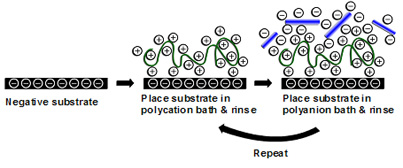
To build up structured cellulose-containing films, we have been making polyelectrolye multilayers containing cellulose nanocrystals. , The anionic polyelectrolyte in traditional polyelectrolyte multilayers may be replaced by cellulose nanocrystals with surface anionic groups. We have coated silicon substrates with nanocrystal-containing multilayers where poly(allylamine hydrochloride) (PAH) was the cationic component.

Schematic (not to scale) of multilayer build-up containing cellulose nanocrystals.
The morphology of the multilayers was studied by AFM and scanning electron microscopy, and film growth was characterized by x-ray photoelectron spectroscopy, ellipsometry and optical reflectometry. Relatively few deposition cycles were needed to give full surface coverage, with film thicknesses ranging from 10 nm to 500 nm. The films displayed iridescent colours, but in this case the colours were due to thin film interference, and not to the chiral nematic reflection that we first observed for thicker films of pure cellulose nanocrystals. This relatively straightforward aqueous layer-by-layer self-assembly technique thus provides a route to smooth, stable nanocomposite films containing cellulose. [Morphological and Optical Characterization of Polyelectrolyte Multilayers Incorporating Nanocrystalline Cellulose, Emily D. Cranston and Derek G. Gray, Biomacromolecules, 7(9), 2522-2530 (2006)]

Photographs of iridescent colors seen in spin-coated LBL films of cellulose nanocrystals and PAH on Si.